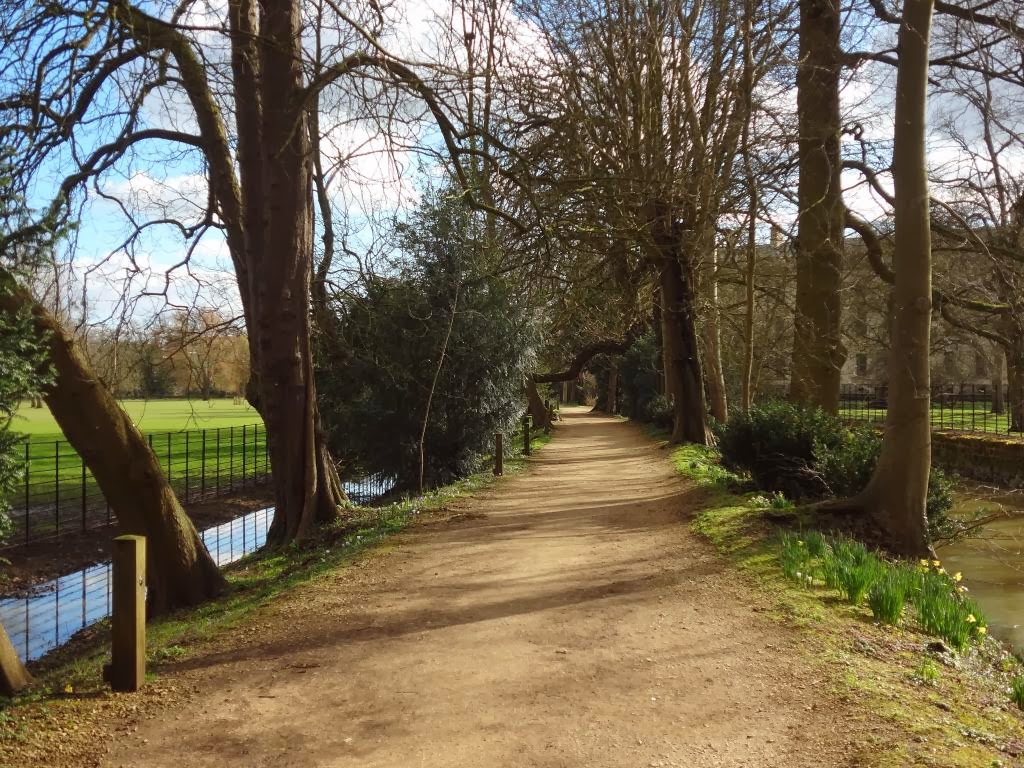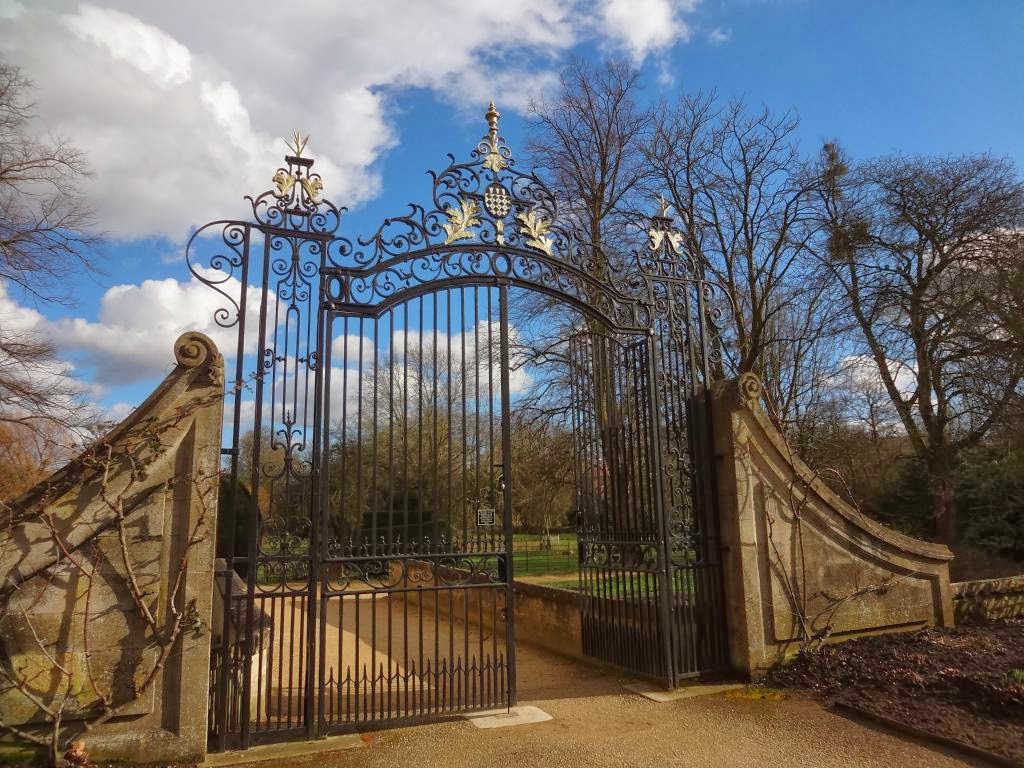
On an early Sunday morning, September 20, 1931, three 30-something English professors took a stroll together on Addison’s Walk in the grounds of Magdalen College at the University of Oxford:
- 32-year-old C. S. Lewis (Fellow and Tutor of English Literature at Magdalen College, Oxford),
- 39-year-old J. R. R. Tolkien (Rawlinson and Bosworth Professor of Anglo-Saxon at Oxford), and
- 35-year-old Hugo Dyson (Tutor and Lecturer at Reading University).
Their time together had begun the evening before at dinner, but their conversation went late into the night.
After Tolkien left around 3 a.m., Lewis and Dyson continued talking until they retired at 4 a.m.
The following Tuesday (September 22), Lewis recounted the scene to his longtime friend and correspondent, Arthur Greeves:
We began on metaphor and myth—interrupted by a rush of wind which came so suddenly on the still, warm evening and sent so many leaves pattering down that we thought it was raining. We all held our breath, the other two appreciating the ecstasy of such a thing almost as you would.
We continued (in my room) on Christianity: a good long satisfying talk in which I learned a lot: then discussed the difference between love and friendship—then finally drifted back to poetry and books.
Later in the letter, discussing the writings of William Morris (a 19th-century English novelist and poet who had greatly influenced Lewis from his youth), Lewis notes:
These hauntingly beautiful lands which somehow never satisfy,—this passion to escape from death plus the certainty that life owes all its charm to mortality—these push you on to the real thing because they fill you with desire and yet prove absolutely clearly that in Morris’s world that desire cannot be satisfied.
The [George] MacDonald conception of death—or, to speak more correctly, St Paul’s—is really the answer to Morris: but I don’t think I should have understood it without going through Morris. He is an unwilling witness to the truth. He shows you just how far you can go without knowing God, and that is far enough to force you . . . to go further.
The following month (October 18), Lewis wrote to Greeves again about their conversation:
Now what Dyson and Tolkien showed me was this: that if I met the idea of sacrifice in a Pagan story I didn’t mind it at all: again, that if I met the idea of a god sacrificing himself to himself . . . I liked it very much and was mysteriously moved by it: again, that the idea of the dying and reviving god (Balder, Adonis, Bacchus) similarly moved me provided I met it anywhere except in the Gospels. The reason was that in Pagan stories I was prepared to feel the myth as profound and suggestive of meanings beyond my grasp even tho’ I could not say in cold prose ‘what it meant’.
Now the story of Christ is simply a true myth: a myth working on us in the same way as the others, but with this tremendous difference that it really happened.
You can watch below an imaginative reconstruction of their conversation:
Years later Lewis wrote a poem entitled “What the Bird Said Early in the Year,” which not coincidentally is set in Addison’s Walk, and has to do with a spell becoming undone.
I heard in Addison’s Walk a bird sing clear:
This year the summer will come true. This year. This year.Winds will not strip the blossom from the apple trees
This year, nor want of rain destroy the peas.This year time’s nature will no more defeat you,
Nor all the promised moments in their passing cheat you.This time they will not lead you round and back
To Autumn, one year older, by the well-worn track.This year, this year, as all these flowers foretell,
We shall escape the circle and undo the spell.Often deceived, yet open once again your heart,
Quick, quick, quick, quick!—the gates are drawn apart.
Let him who has ears to hear, hear.

Postscript
Some readers might wonder about the relationship between this event and Lewis’s conversion to theism, and then his actual conversion to Christianity.
Conversion to Theism
In his 1955 memoir, Surprised by Joy, Lewis famously tells his readers that he finally abandoned his resistance to God, becoming “the most dejected and reluctant convert in all England,” in the Trinity Term (the eight weeks from late April to late June) in 1929.
That dating would seem to settle the matter. And it did for virtually all Lewis scholars, until Alister McGrath was researching the question for his 2013 biography, C. S. Lewis—A Life: Eccentric Genius, Reluctant Prophet. In short, McGrath believes that Lewis was off by one year in his recollection, and that it was actually Trinity Term of 1930 (possibly in mid–June). If McGrath is correct, then the conversation with Tolkien (September 1931) was a little more than a year after Lewis began to believe in God (June 1930).
McGrath came to this conclusion for four reasons:
First, . . . a close and continuous reading of his works—especially his correspondence—reveals no sign of a significant change in tone or mood throughout 1929, and even in early 1930. Between September 1925 and January 1930, Lewis’s writings disclose no hint of any radical change of heart or mind, or even a pending change. If Lewis was converted in 1929, this supposedly pivotal event seems to have made no impact on his writings—including his letters to his closest friends at that time, Owen Barfield and Arthur Greeves.
Second, Lewis’s widowed father died in September 1929. If Lewis’s chronology of his own conversion is accepted, Lewis had come to believe in God at the time of his father’s death. Yet Lewis’s correspondence makes no reference at all to any impact of a belief in God, however emergent, upon his final days spent with his father, his subsequent funeral, and its emotional aftermath. Might, I wondered, the death of Lewis’s father have been a stimulus to him to think about God, rather than something he approached from an existing theistic perspective? If Lewis discovered God in the summer of 1930, his father’s death the previous year might well have marked a turning point in his thinking.
Third, Lewis’s account of the dynamics of his conversion in Surprised by Joy speaks of God closing in on him, taking the initiative, and ultimately overwhelming him. We find echoes of this language in a short letter from Lewis to Owen Barfield, written hastily on 3 February 1930, which speaks of the “spirit” becoming “much more personal,” “taking the offensive” and “behaving just like God.” Lewis asked Barfield to come and see him soon, before he made a rash decision to “enter a monastery.” Barfield was later unequivocal about the significance of this letter for Lewis’s spiritual development: it marked “the beginning of his conversion.” The letter reflects Lewis’s language about the pressures he experienced immediately before his conversion. Yet this conversion is clearly ahead of him, not behind him.
Fourth, Lewis makes it clear that his behaviour changed as a result of his new belief in God. Although still not committed to Christianity, he now began to attend both his local parish church on Sundays, and college chapel on weekdays. Yet Lewis’s correspondence makes no reference to regular attendance at any Oxford church or Magdalen College chapel in 1929, or the first half of 1930.
Yet things change decisively in October 1930. In a letter to his close friend and confidant Arthur Greeves, dated 29 October 1930, Lewis mentions that he now goes to bed earlier than he used, to, as he has now “started going to morning chapel at 8.” This is presented as a new development, a significant change in his routine, dating from the beginning of the academic year 1930–1. The date of this change of habit makes sense if Lewis discovered God in the summer of 1930—perhaps in June 1930, right at the end of the academic year. This would explain Lewis starting to attend college chapel in October 1930. The Oxford academic year resumes in October, thus giving Lewis the opportunity to begin attending college chapel regularly.
McGrath further notes that Lewis was “unreliable when it comes to relating his internal and external world.”
When it comes to dates, months, and days, Lewis gets things muddled. Lewis himself remarked on this failing in 1957, shortly after the publication of Surprised by Joy: he could now, he confessed, “never remember dates.” His older brother Warnie declared that Lewis had a “life-long inability to keep track of dates.” When Lewis became Vice-President of Magdalen College, Oxford in 1941—a fixed-term appointment with essentially administrative responsibilities, which rotated around the fellowship—he was soon found to be incapable of carrying out one of the chief responsibilities of this role: arranging for the booking of rooms for college meetings or private engagements. Lewis simply could not remember dates. Rooms were double-booked—if they were booked at all.
Conversion to Christianity
On September 28, 1931—just nine days after Lewis’s conversation with Tolkien on Christ being the true myth—Lewis took the final step in embracing the divinity of Christ while riding in his older brother’s motorcycle sidecar on the way to the newly opened Whipsnade Park Zoo in Bedfordshire. He recounts:
I know very well when, but not how, the final step was taken.
I was driven to Whipsnade one sunny morning. When we set out I did not believe that Jesus Christ is the Son of God, and when we reached the zoo I did.
Yet I had not exactly spent the journey in thought.

















